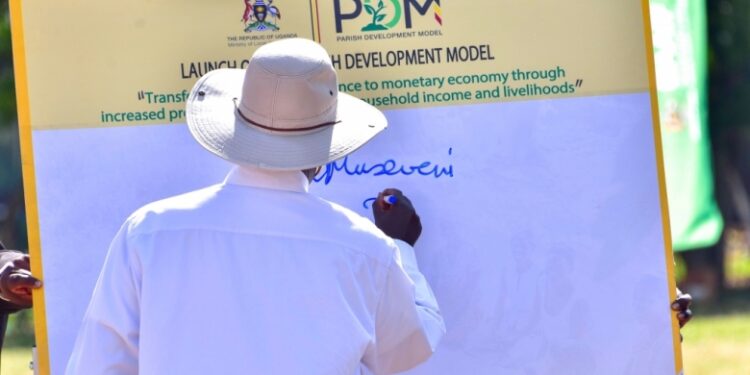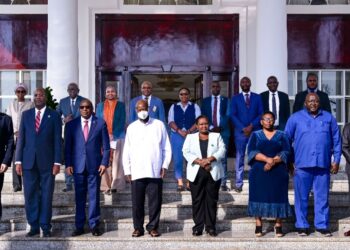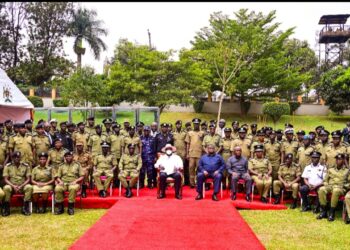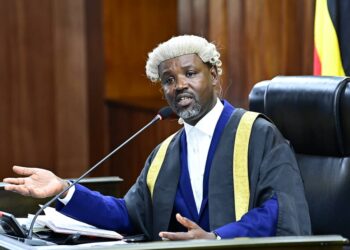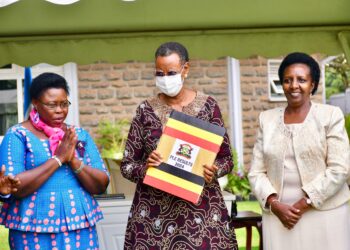President Yoweri Kaguta Museveni, who also serves as the Head of the National Policy Committee overseeing the Parish Development Model (PDM), is continuing his nationwide tour to assess the program’s progress.
As he engages with stakeholders and directly witnesses the outcomes, the critical question arises: Has the PDM truly delivered tangible results, or does it face persistent obstacles that may hinder its potential?
Introduced by President Museveni on February 26, 2022, the PDM has quickly become a central pillar of Uganda’s poverty reduction strategy. Part of the broader Vision 2040, the PDM aims to transform Uganda’s economy by transitioning from subsistence agriculture to a more modern and prosperous market-driven economy.
Specifically targeting rural households—often the most impoverished and dependent on subsistence farming—the model represents an ambitious effort to stimulate economic growth and reduce poverty. A whopping UGX42 trillion was set aside for the program.
With the PDM now entering its third year of implementation (2020/21–2024/25), it’s clear that while progress has been made, challenges persist. Its impact can be measured in both achievements and ongoing hurdles. The initiative is structured around a multi-sectoral approach, focusing on seven key pillars: agricultural and non-agricultural production, infrastructure development, social services, financial inclusion, mindset change, community-driven data systems, and governance. These areas aim to build a more inclusive economy by promoting entrepreneurship and enhancing household incomes, particularly for the most marginalized groups in Uganda.
One of the central components of the PDM is its financial backing for each parish. Starting with an allocation of UGX 17 million in its first year, increasing to UGX 100 million annually, the initiative targets 100 households per parish each year. By 2024, the program is expected to help 17.5 million Ugandans escape poverty, focusing on boosting agricultural practices, livestock management, and small-scale industries.
The PDM has already seen success in areas like Karamoja, traditionally one of the poorest regions in Uganda. A compelling example is Emmanuel Lokong, a piggery farmer from Nakapiripirit. Once earning just UGX 80,000 a month, Lokong has seen his income soar after receiving financial support through a local PDM SACCO and training in modern agricultural techniques. Now managing a thriving piggery business, he expects to earn over UGX 8 million from selling his pigs.
Lokong’s story, which echoes in several other parts of Uganda, highlights the program’s potential to transform the lives of smallholder farmers, particularly through the introduction of SACCOs. These community-based savings and credit cooperatives have made loans more accessible to vulnerable populations, offering favorable terms compared to traditional banks.
In April 2024, Mr. Willis Bashasha, the Director of the Manifesto Implementation Unit, reported that the PDM has successfully covered 63% of its action areas. He also emphasized that special interest groups, including the youth (29%) and the elderly (13%), are integral to the model’s design. The proportion of female beneficiaries is higher than male, with women making up 55% of those impacted by the program. The success rate, according to Basha, has improved significantly since May 2023, when achievement levels were calculated at only 20%. This upward trend reflects a positive shift in the program’s execution.
Another noteworthy development is the investment in infrastructure, which has been essential in linking farmers to markets. Road construction, the expansion of energy and water systems, and enhanced ICT access have all facilitated better service delivery and created opportunities for rural communities to connect with broader markets.
Additionally, mobile financial services like PostBank’s WENDI mobile wallet have provided beneficiaries with convenient access to funds, eliminating the need for long trips to distant banking institutions.
However, despite these successes, the PDM faces significant challenges. Insecurity, particularly in regions like Karamoja where cattle rustling is prevalent, remains a major obstacle. Theft of livestock, crops, and agricultural equipment continues to undermine the potential benefits of the PDM, frustrating the efforts of farmers trying to lift themselves out of poverty. While the government has emphasized that peace is essential for economic development, the persistent security challenges in certain areas pose a serious risk to the model’s success.
Market access and affordable credit also remain key hurdles. Despite the financial resources being made available through the PDM, farmers continue to struggle with low prices for their produce, high input costs, and limited access to larger, more profitable markets. These barriers prevent farmers from maximizing their potential, hindering the economic transformation that the PDM seeks to achieve. Furthermore, limited capacity at the local government level to implement and monitor projects, coupled with the challenges of climate change—such as droughts and floods—continues to disrupt the livelihoods of rural farmers.
As President Museveni continues his nationwide tour to monitor the program’s effectiveness, the future of the PDM will rely on the collective efforts of both the government and the people.
With continued focus on peace, innovation, and sustainable development, there remains hope that the PDM will be able to overcome its current obstacles and fulfill its promise to reduce poverty and promote economic growth across Uganda.
Do you have a story in your community or an opinion to share with us: Email us at editorial@watchdoguganda.com


